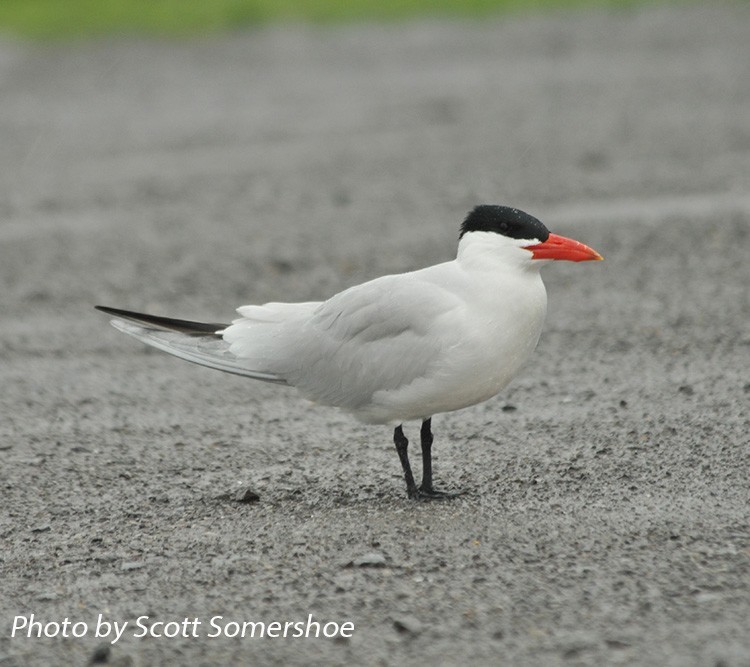Caspian Tern
Hydroprogne caspiaThe Caspian Tern is as large as a gull, but it is easily identified as a tern by its large coral-red bill. It is the largest tern in the world, and ranges worldwide with the exception of Antarctica.
In North America, it breeds in scattered locations along the Atlantic, Gulf and Pacific coasts, as well as inland in the prairies and along the Great Lakes. In winter, the North American populations winter along the southern Atlantic, Pacific and Gulf Coasts as far south as northern South America.
The Caspian Tern is an uncommon migrant in Tennessee, more frequently seen in the fall, and occasionally seen in large flocks of 100 or more individuals.
Description: This large, gull-like tern has a black cap, and a large, thick, black-tipped red bill. It is pale gray above and white body below, with gray primaries on the underside of the wing, and a white, relatively short, slightly forked tail.
Immature birds (July-October) have a blackish crown, somewhat modeled back feathers, and the bill can appear orange. Often hovers above the water before diving.
Length: 21"
Wingspan: 50"
Weight: 1.4 lb.
Voice: Call is a deep, harsh raspy kowk.
Similar Species:
- Superficially like a gull, but Caspian Tern has a red pointed bill, and black or blackish cap year round.
Habitat: In Tennessee, found on large lakes and rivers.
Diet: Almost entirely fish, but occasionally crayfish and insects.
Nesting and reproduction: The Caspian Tern has never been known to nest in Tennessee.
Status in Tennessee: Uncommon spring and fall migrant, and rare winter visitor across the state. More frequently seen in the fall, when large flocks are occasionally found. May be present in the state from mid-April to mid-May, and from late July to early November, but occasionally also in winter.
Fun Facts:
- The largest Caspian Tern colony in North America is inconveniently located in the Columbia River in Oregon, where young salmon, some of them threatened or endangered species, makeup 74% of the tern's diet. Attempts to move the colony, starting in the late 1990s, are beginning to be successful.
- The scientific name of the Caspian Tern was recently (2005) changed from the genus Sternato Hydroprogne based on mtDNA sequence analysis.
- The oldest known wild Caspian Tern lived to be more than 29 years and 7 months old. The average life span of Great Lakes Caspian Terns is estimated to be 12 years.
Best place to see in Tennessee: Seen in late summer (late August) on large lakes and reservoirs, although infrequently encountered.
